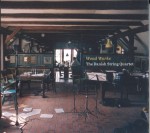 There is some simply beautiful music on Wood Works, the latest CD from the Danish String Quartet (Dacapo 8.226081), but it’s not necessarily what you would expect to hear. In their description of the recording the quartet members say that they borrowed a selection of Nordic folk tunes that are very close to their hearts and “let the music flow through the wooden instruments of the string quartet.” All but one of the 13 tracks are arrangements by the quartet members, and they are very effective, retaining the simplicity of the folk music while adding a quite modern touch in places. Some of the tunes, as you would expect, are clearly fiddle-based in origin, but there is a lovely range of mood and tempo here. I’m not sure why they felt it necessary to add an anonymous jazz trumpet solo to Five Sheep, Four Goats, though!
There is some simply beautiful music on Wood Works, the latest CD from the Danish String Quartet (Dacapo 8.226081), but it’s not necessarily what you would expect to hear. In their description of the recording the quartet members say that they borrowed a selection of Nordic folk tunes that are very close to their hearts and “let the music flow through the wooden instruments of the string quartet.” All but one of the 13 tracks are arrangements by the quartet members, and they are very effective, retaining the simplicity of the folk music while adding a quite modern touch in places. Some of the tunes, as you would expect, are clearly fiddle-based in origin, but there is a lovely range of mood and tempo here. I’m not sure why they felt it necessary to add an anonymous jazz trumpet solo to Five Sheep, Four Goats, though!
On the sleeve notes the quartet wonders “Does it work?” Yes, it does. It’s a charming, relaxing and thoroughly satisfying CD.
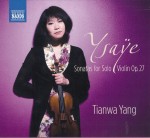 Violinist Tianwa Yang has often been featured in this column over the past few years, mainly because of her outstanding Naxos series of the complete violin music of Pablo Sarasate, and she has now let loose her remarkable talents on the Sonatas for Solo Violin Op.27 by Eugene Ysaÿe (Naxos 8.572995).
Violinist Tianwa Yang has often been featured in this column over the past few years, mainly because of her outstanding Naxos series of the complete violin music of Pablo Sarasate, and she has now let loose her remarkable talents on the Sonatas for Solo Violin Op.27 by Eugene Ysaÿe (Naxos 8.572995).
This is the fourth CD I’ve received that features all six of these astonishing works, arguably the greatest contribution to the solo violin repertoire since the Bach Sonatas & Partitas that were, in part, their inspiration, and it again highlights the difficulty in trying to make comparisons between the various versions. There are close to two dozen currently available on CD, and while many of the biggest names are missing there are certainly enough outstanding recordings to make choosing a top recommendation virtually impossible.
The good news, of course, is that there’s no need to. This is clearly one of those epic works – like the Bach unaccompanied – where owning one version is simply never enough. Tianwa Yang’s current performance, where her faultless technique enables her to delve deeply into the heart of these remarkable sonatas, is certainly one that you’ll want and will keep going back to.
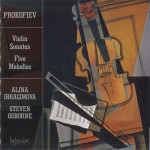 The brilliant young Russian violinist Alina Ibragimova adds yet another stunning CD to her catalogue with Prokofiev Violin Sonatas and Five Melodies (Hyperion CDA67514). Cédric Tiberghien, her regular keyboard partner, is missing this time, but the outstanding British pianist Steven Osborne proves to be an ideal choice as replacement.
The brilliant young Russian violinist Alina Ibragimova adds yet another stunning CD to her catalogue with Prokofiev Violin Sonatas and Five Melodies (Hyperion CDA67514). Cédric Tiberghien, her regular keyboard partner, is missing this time, but the outstanding British pianist Steven Osborne proves to be an ideal choice as replacement.
Prokofiev’s music for violin and piano seems to be attracting a lot of recording attention these days: this is the third CD of the same three works to come my way just this year, following the James Ehnes and Jonathan Crow discs reviewed in this column in February and April respectively.
As fine as those CDs were, Ibragimova proves to be quite irresistible in her performances here, showing the same fire, intensity, subtlety and intellect that helped make her live Wigmore Hall 3CD set of the complete Beethoven sonatas with Tiberghien such a remarkable issue.
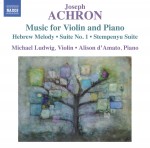 There’s another CD of violin music by the early 20th-century Russian Jewish virtuoso Joseph Achron, this time on a Naxos CD of his Music for Violin and Piano featuring Buffalo Philharmonic concertmaster Michael Ludwig and pianist Alison d’Amato (8.573240).
There’s another CD of violin music by the early 20th-century Russian Jewish virtuoso Joseph Achron, this time on a Naxos CD of his Music for Violin and Piano featuring Buffalo Philharmonic concertmaster Michael Ludwig and pianist Alison d’Amato (8.573240).
Achron not only had a remarkable career as a soloist but also enjoyed great success as a composer, although his music fell out of favour following his death in 1943, just short of his 57th birthday. Most of his works have remained unpublished, and those that were in print suffered badly: his early publishers went out of business following the Russian Revolution, and nearly a dozen works published by Universal Edition were forced out of print by the Nazis when Achron was blacklisted in the 1930s. Achron’s music does seem to be making a comeback, however. Hagai Shaham’s terrific 2CD Hyperion set of the Complete Suites for Violin and Piano was reviewed in this column in September 2012, and Naxos has also issued the Violin Concerto No.1 in a performance by Elmar Oliveira.
The titles here are mostly short early pieces from before the First World War that encompass many different moods. Michael Ludwig’s big, rich tone is perfectly suited to the style and nature of Achron’s music, deeply influenced as it was by Jewish folklore and melodies, and he and d’Amato give performances that are idiomatic and technically stunning.
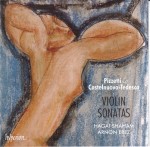 By coincidence, there was also a new CD by the afore-mentioned Hagai Shaham in a recent selection of discs, this time featuring Violin Sonatas by Italian composers Ildebrando Pizzetti and Mario Castelnuovo-Tedesco with Arnon Erez as keyboard partner (Hyperion CDA67869). Both composers died in 1968, but Castelnuovo-Tedesco was 14 years the younger, and studied with Pizzetti in his youth.
By coincidence, there was also a new CD by the afore-mentioned Hagai Shaham in a recent selection of discs, this time featuring Violin Sonatas by Italian composers Ildebrando Pizzetti and Mario Castelnuovo-Tedesco with Arnon Erez as keyboard partner (Hyperion CDA67869). Both composers died in 1968, but Castelnuovo-Tedesco was 14 years the younger, and studied with Pizzetti in his youth.
Both are represented here by a single sonata and three short songs.
Pizzetti’s Violin Sonata in A Major dates from 1918-19, and although it premiered to somewhat mixed reviews it was considered to be a major addition to the Italian chamber music repertoire, Castelnuovo-Tedesco devoting an in-depth article to it in a 1920 Turin music magazine. It’s an easily accessible work with – not unexpectedly – clear links to the war years; the central movement is a Prayer for the Innocents. The Tre canti from 1924 were transcribed by Pizzetti from his original cello and piano version.
Castelnuovo-Tedesco’s Sonata quasi una fantasia Op.56 was written in 1929, and features a big, sweeping first movement that makes great technical demands on the players, a dance-like middle movement and a calm epilogue. The Tre vocalizzi Op.55 were written the previous year for wordless voice and piano, and arranged for violin in 1930 by Mario Corti, an early advocate of the violin sonatas of Pizzetti and Respighi. Not surprisingly, perhaps, there are touches of Respighi here, but they’re lovely pieces, really stretching the violinist and ending with a delightful Tempo di Fox Trot (“American Music”).
Shaham’s playing is, as always, passionate and seemingly effortless in its handling of the technical challenges, but his constantly fast and intense vibrato can be a bit unsettling at times. The overall balance is fine, but there are moments when the two performers seem somehow to be a bit disconnected.



